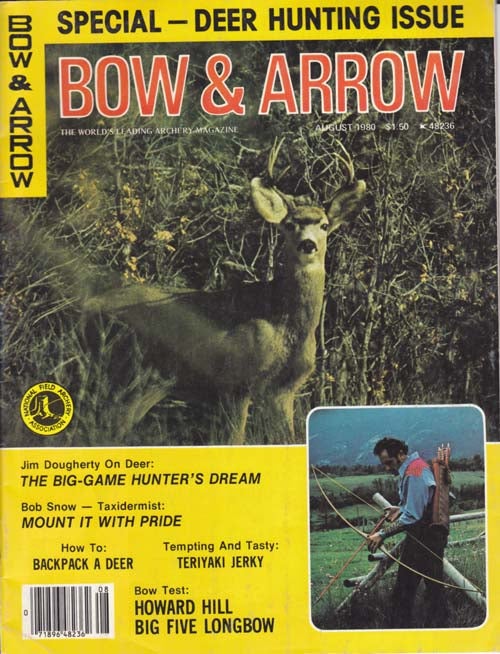
BOW & ARROW
August 1980
Howard Hill Big Five Longbow – Bow Test
HOWARD HILL was a legend long before his passing in
February of l975. He was the man who started my
generation shooting the bow and arrow. And we all began
with some form of the longbow, however humble the particular model happened to be.
We young enthusiasts sometimes had the great good luck
of catching Mr. Hill in one of his short films. For a quarter,
our parents could get rid of us for about a half-day at the
movies, with a cartoon, sometimes two, a main feature and
a serial calculated to keep us in suspense and to return next
Saturday to see how Flash Gordon made out against the
evil forces of Space.
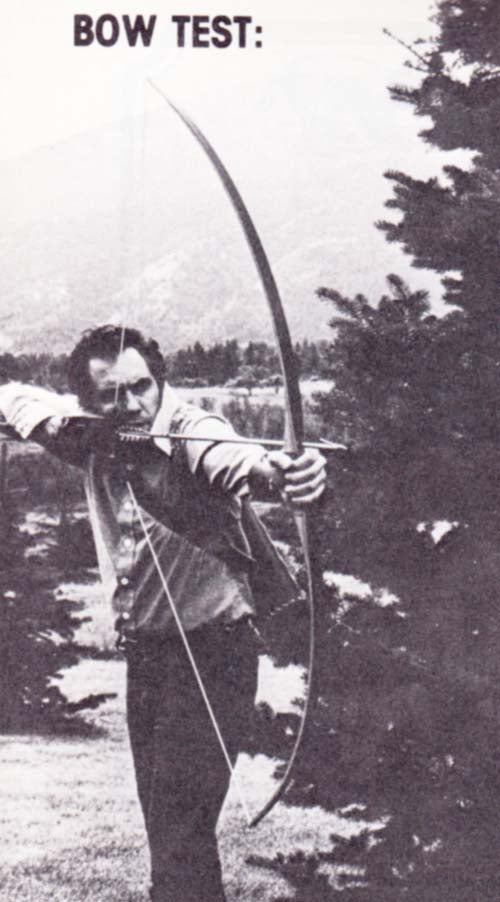
In between the feature and serial, we often had a “select-
ed short subject.” Sometimes they were dull, and l suspect
that an educator in the community was bribing or threatening
the theater manager to slip these in. But one afternoon,
the short was anything but dull. It was Howard Hill himself,
doing things with a bow that didn’t seem possible to us.
The gang was already into some form of archery, but it
was Hill who drew us away from the horrible mismated
archery tackle to balanced tools. My first bow, in fact, was
an oleander limb whacked off of my grandfather’s hedge, a
stretch of packing twine for a string and milkweed reeds for
arrows. Self-bows were next. They were often lemonweed,
and not all that bad, but too thin of core and too flat of
limb. They only cost a few bucks to buy and arrows for
them were twenty-five cents. Mine drew around twenty-five
pounds. I still have it.
The yew bow was a romantic and suitable model. But
back in these carefree days of the twenty-five-cent movie
in the l950s when this writer was a ripe IO years old we
began to tune in on the Hill archery song the handsome bows
with matched equipment to go with them, longbows. By
way of definition, these bows were indeed long, certainly
sixty inches and more often sixty-six inches and more, and
they were thick of core and narrow of limb with graceful
tips to nock the string.
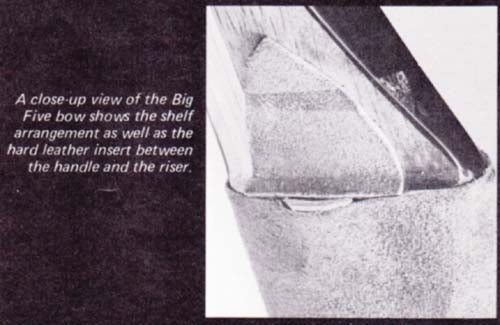
The Howard Hill Company of Hamilton, Montana, is and
has been offering a replica, as it were, of the Hill-style bow,
and the particular model which crossed my hands for a test
run was their top-of-the-line Big Five model. The Big Five,
according to the literature and information given me by Mrs.
Betty Ekin, friend of Howard Hill and, along with son Craig,
operator of the Howard Hill Archery Company, was patterned
after the famous “Sweetheart” bow of Hill’s.
This top-of-the-line model is the one I preferred to test,
as I try to do with all companies’ bows. The construction of
the bow is per Hill’s design. That is, the core is bamboo.
Anyone who looks into the older books referring to Hill’s
bows will recall that Howard preferred bamboo for his limb
laminations. The current Hill Company has followed suit
and is still using the particular bamboo which Hill deter-
mined was best. Those of you who may, perhaps, flyfish,
may be familiar with the “temper” and action of the more
expensive “split bamboo” flyrods. The same criteria of
action and resiliency which make a flyrod “alive” also make
the longbow feel alive in the hand.
The specific type of bamboo, of course, is important as
all bamboo is not created equal. Hill reportedly took a trip
to Japan in 1960 in order to find and ship home a specific
species of bamboo he found most suitable for his needs, and
I am told that the Hill Company still uses this species in the
bow’s construction to date.
Obviously we are speaking of the heart of the bow when
we talk bamboo. This heat-treated bamboo, which of course
has been split into thin lengths, is then laminated together
to form the thick, but narrow core of the true longbow type.
As a simple matter of rule, I noticed that the Hill’s bows rank
according to number of laminations, the top of top-of-the-line
Big Five having four strips of bamboo, the Tembo with three
and the Half Breed with two. I cannot say that the bows with
only two laminations or three, are not fine-shooters too, because
my previous tests show that they are; however, the price being
reasonable anyway, the Big Five is surely one to look at as
a bargain.
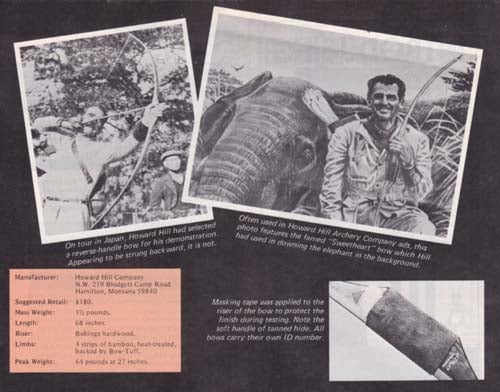
The Belly and face of the bow are both backed by glass on the
Big Five, in this case, Bow-tuff, a brand with which we are all
familiar. The riser is Bubbinga hardwood, another material we all
know well. Though not an elaborately beautiful wood, Bubinga is
a sturdy and entirely suitable in the longbow. The traditional longbow
riser is going to sport a handle of tanned leather anyway, covering
most of the wood. The shelf of the bow consists of a small hunk of
very hard tanned hide which is tucked underneath the leather handle.
Another piece of hide is used against the side of the handle
where the arrow would make contact.
Shooting off the shelf is, of course, standard practice
with the longbow, and it sometimes bothers those who have
not tried this type of bow. It should not. Shooting off the
shelf works fine. If a very special arrow rest were attached to
the bow, there is no doubt that a few foot-seconds of speed
would be picked up, but shooting from the shelf offers fine
control and very easy handling of the shaft from nocking to
controling during the holding of the bow at fulldraw. l prefer
to shoot off the shelf with a longbow and will not attach
a rest to one.
The nocking ends of the bow are traditionally pointed and
very lean. And, contrary to the way things might look,a long-
bow tends to remain strung admirably well. l have never in
my life had one become unstrung in the act of shooting, in
fact, and I have shot a good many longbows. There is an enforcer
strip of glass laminations on both ends of the Big Five.
This is a sandwiched piece of glass that tapers thin.
The final finish of the bow is excellent with the exception
of a couple places where it looks as though there was an
epoxy run, or lumping of final liquid finisher. The widest `
part of the limb is about 1 1/4 inches. That will i seem slim to
anyone used to the limbs on a compound, and it is also
quite narrow as compared with the recurves of the Fifties
and Sixties that were sold primarily over the counter. It is a
matter of what fits where, and the narrow limb on the long-
bow is a plus factor, The core, that is the thickness of the
bow as viewed from the side upward from the riser and down
from the riser, is thick, in this case about seven-sixteenths-
inch at the widest measure.
The particular longbow that I elected to test turned out
to be a draw weight of sixty-four pounds thrust at twenty-
seven inches pull. I would have preferred a seventy-pound
draw at twenty-eight inches; however, I did overdraw the
bow by one inch in the test so that I ended up with a force
of sixty-seven pounds. This was close enough, as I do like to
keep all my test bows within a range of about seventy pounds
pull. Overdrawing is not the best practice in the world, by
the way, but for the few shots I had to fire over the chronograph
screens, plus less than fifty darts tossed at the targets,
the bow was not in any sense harmed.
All in all, those are the physical characteristics of the
Howard Hill Company’s Big Five longbow. However, the
reader may be curious about the name itself. As already
stated, the Big Five is a direct copy of the old Sweetheart
bow of Hill’s, and it was that bow which went on the famous
safari after the “big five” of Africa. Hill took three elephants
on that trip, I am told, firing four arrows for all three
from his 115—pound bow. Back in the Fifties, when the feat
was fresh, wild stories flew all around the archery world that
Hill had used a 150-pound bow and so forth, but it was the
II5-pound model that did the trick, firing special forty-one-
inch arrows.
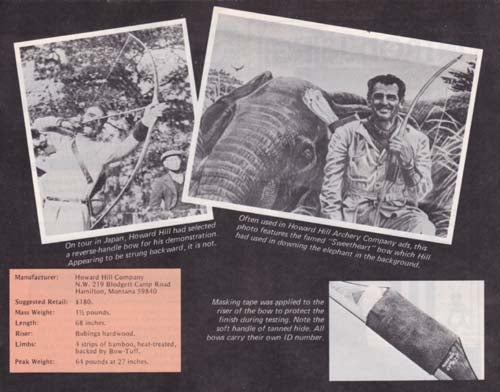
Hill’s bows were set up for a twenty—eight-inch draw, I do
believe, and that has been considered a standard for many
years. While Hill was not a weight lifter, he was a powerful
man who had a good set of arms on him, However, he apparently
credited his ability to totally master the eighty,
ninety and one hundred-plus-pound bows to building up to
them. Naturally, a whole different set of muscles apply to
drawing the bow, and I have seen many a strong man shudder
and shake trying to draw a bow of far less than eighty
pounds pull.
Hill did not advocate going to heavy bows that were not
manageable by their owners. Of course this is correct, but
we should not misconstrue the statement as some have. Hill
was not in favor of sticking with a light bow just because it
could be easily mastered. He elected for the heaviest bow a
person could shoot with comfort. That means, he wanted us
to build into our bows, finding a place where we could
master a given poundage.
In shooting the longbow, it is difficult to explain how
to aim one. I have never had any luck trying to tell some-
one how to hit a target with a longbow, although Hill at-
tempted to teach a split-image design of aiming. I am not
certain that is what he called it, but the term seems to be
correct. Simply, a longbow is fired-pretty much the way
we toss a rock. A rock has no sights. And yet I’d bet that
no one reading this would have any trouble coming pretty
close to a tin can at ten feet, thirty feet, twenty yards;
even much farther. And·we have darn little practice at
rock throwing, too.
Since there are no sights on the longbow (although
there certainly have been sights on some longbow models
out of the past) it is best to grab up the bow, nestle the
hand comfortably into the leather grip without choking
the grip down, and then moving the bow around a bit to
get the feel of it. Remember, the entire mass weight of the
Big Five is only one pound and six or so ounces.
The bow can be held without undue strain in the bow-
hand, by the way, as the handle wedges back into the palm
just as with any other bow type, and this is the best way
to shoot, without choking down on the grip. The same
anchor point the archer uses for his compound may not
be fitting for longbow shooting, although I find no problem
using the same point. The left arm is somewhat crook-
ed in drawing the longbow and the archer leans into his
work, rather than standing straight up. The bow is usually
canted, or tilted off to one side, which not only aids
in maintaining the arrow balanced on the shelf, but also
allows for the head to be bent a little, too. The bending
of the head puts the eyes in line with the shaft and the
target.
All I can say is that something unconscious soon takes
over and the archer is popping arrows into the target butt.
I like to think l keep my eyes on the target and not the
tip of the arrow, but I am told by smarter men than l
that the eye does dart back and forth from target to
arrow tip. I am not going to consciously try to discover
whether it does or not. `
The fistmele on this bow will be terribly small by the
standards of the old recurves and the modern compounds.
In fact, shooters may have trouble with this, sometimes
turning the riser so that the string snaps into the arm.
Naturally, it is wise to use an arm guard But the shooter
should not try to make the fistmele dimension wider. It
will normally slow the bow down and decrease the cast
and sometimes upset the arc of the arrow. The fistmele
is properly short, and on my test model it was only 5 3/4
inches from the back of the riser to the string.
The riser is standard on the Big Five. That is, it points
inward to the hand as per normal/average. However, Hill
did use some models which were reverse handle. I have
such a bow and I am forever asked “Why did you string
your bow backwards?” It is not strung backwards. The
handle is fitted that way to offer a different type of grasp
for the hand.
In stringing the Big Five, I used my stringer. That
makes sense to me. I never did care for the step-through
method, because even with a stable-limbed longbow, a
twisted limb is still a possibility. There is also the push-
away method, and that works all right. I may not have
developed the particular muscles necessary to master
the latter, and with my own seventy-pound longbow, I
have a hard time stringing it with the push-away, so I
have gone to the stringer. Sissy, maybe, but it works.
Hill Company has suggested the stringer too, incidentally.
As for arrows, the plain old cedar shaft is still mighty
good in the longbow, but I have successfully fired all
types of materials. The quick recovery of the cedar shaft
is hard to beat. Remember, the arrow has to, in fact,
dart around the riser of the bow and then spring back
into the line of arc. Therefore, the resilient cedar shaft
is a good one. I was surprised to see the true all·graphite
shaft work well, too. The shaft was a Lamiglas, which
is not part graphite, but all graphite.
Only these two arrows were used for shooting, as I had a
dozen of each around. The cedars were trimmed to twenty-
eight inches from the inset of the nock to the very tip of the
arrow and then the arrow was drawn back until the tip rest-
ed full on the shelf.
As for the Lamiglas arrows, they were left full length as
they are so very light anyway, and contrary to what we might
think, the longer pure graphite arrow is stronger than a short-
er pure graphite arrow. At least, this is what I am told by an
engineer who is in the business. Therefore, I have left my
graphite arrows at a full thirty-one-inch draw. With my favorite
compound I have trained myself away from the long 31 1/4 inch
draw I used to have, down to a more useful twenty-nine-inch draw.
I like a twenty-eight-inch draw in the longbow. We sometimes get
carried away with getting our equipment tuned and forget that we
can tune ourselves, too. Our bodies bend. And we can change a
draw length to some degree. It is no trouble to relax into the longbow,
lean into it, bend the elbow and enjoy a nice twenty-eight-inch draw
and the resulting lighter stiffer arrow.
The cedar arrow attained a velocity or 176 feet per second (fps).
This arrow, however, was a shade overweight for
the bow, being an Acme premium cedar in 70/75-pound
spine. l might have gotten the bow to stabilize well with a
65/70 spine, or even a 60/65 for a target arrow, though the
latter would probably be overcome by a heavy hunting head.
The Acme 70/75 weighed 497.5 grains.The stiff and ultra·light
pure graphite Lamiglas shaft
earned a starting velocity of 192 fps, this arrow weighing
only 434.2 grains. The stiffness and lightness seemed excel-
lent out of this bow, however, and it is a tribute to a good
arrow.
The nocking point was set on the bow by testing, not by
measuring first and then arbitrarily setting it, l simply put
the nocking point so that the arrow was perfectly horizontal
to start with and I moved the nock up on the string just a
little at a time until l was rewarded with a stabilized flight
out to forty yards and beyond. The greatest shooting I did
with the bow was at forty yards.
The arrows were, as per necessity, feather fletched. A
plastic vane will hit the shelf and toss the arrow askew. The
feathers simply fold back on the shelf and allow the arrow
to continue on its path. Unlike the testing of a compound,
the bow was shot “out of the box.” In other words, tuning
was not questioned. The longbow can be tuned, of course, by
changing the weight of the string, or by switching string
length to change fistmele. In short, by manipulating the
variables one at a time and checking arrow flight. Arrow
swapping is in itself bow tuning. But that is another story.
A glove was used, not a release of any kind. That’s nothing
new for me as l use a glove for all my testing, feeling that I
want to know the performance of the bow in the hunting
field as I would use it there. The glove will indeed slow down
the arrow to a small degree, however, and in all fairness this
should be pointed out. I have, in some compounds, picked
up several feet per second by going to a release, but usually,
in an overall contest, a smooth good glove won’t be that far
behind the velocity delivered by a release mechanism.
The newcomer to the longbow, especially the compound
shooter, should relax and enjoy this addition to his sport.
I call it an addition because I shoot both compounds and
longbows. And he should not go too heavy in draw weight.
It’s unnecessary for the most part when targets and deer-
sized game is going to be the main use of the bow. A fifty-
pound longbow will give a lot of pleasure, and when the
shooter builds up to it, a sixty or seventy will do a great
deal of work. If an archer is dedicated enough to spend
time in the back yard, he can build up to a lot of weight
and handle it well. Men of slight build can do it. I have a
shooting acquaintance who is small of stature, yet he fires
an eighty-six-pound longbow with ease and control. Unfortunately,
this peak can be lost if practice is forsaken. You’ve
got to keep in shape.
At the beginning of Winter, l am pretty strong with my
own seventy-pound longbow. By the beginning of Spring,
when Winter has denied me much shooting time, I’m pretty
bad. l should have an identical longbow to my seventy-
pound model that draws about forty-five or fifty to build
up with for the start of the new season each year, or move
to a civilized locale where shooting all year long is possible.
The Howard Hill Company Big Five bow sells, as this is
written, for $l79.95 plus F.E.T. (Federal Excise Tax) and
shipping. A letter to the company at N.W. 219 Blodgett
Camp Road, Hamilton, Montana 59840, will bring a price
list, plus a little catalog of the Howard Hill Company’s bows
and products, as well as some interesting information on
Hill himself. The company also sells arrows, gloves, arm-
guards, strings and other supplies to accompany the bow, all
in the traditional Hill format. And they also offer a few
books to help the archer, such as The Complete Archery
Book by Hochman and Longbow by Hardy.
The longbow, unlike the over-the-counter recurve, has
continued with a rather large following. It’s history is an
extremely interesting one, and a very long one, with no end
in sight, which is the way we would hope to have it. It is
good that an archer can select from different bow styles,
compounds, recurves and longbows, giving him that much
more scope to make his sport that much more interesting.
– Sam Fadala
ARCHIVED BY
www.ARCHERYTALK.com
All Rights Reserved



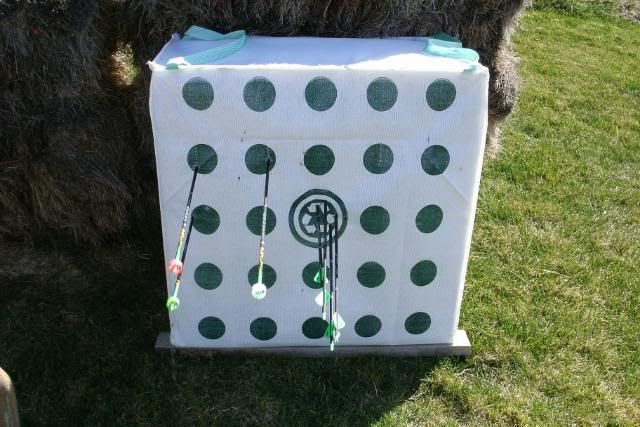
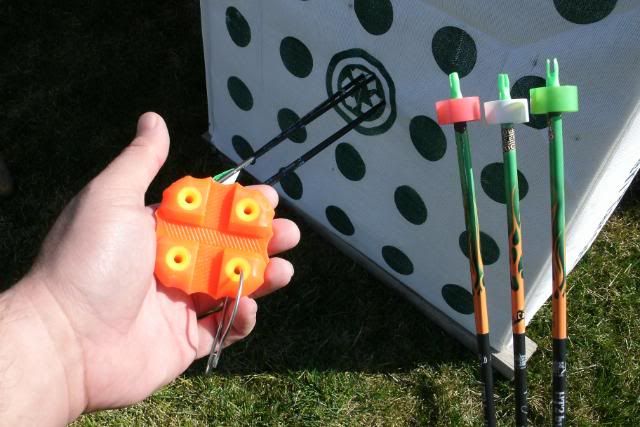

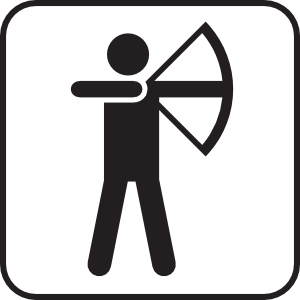





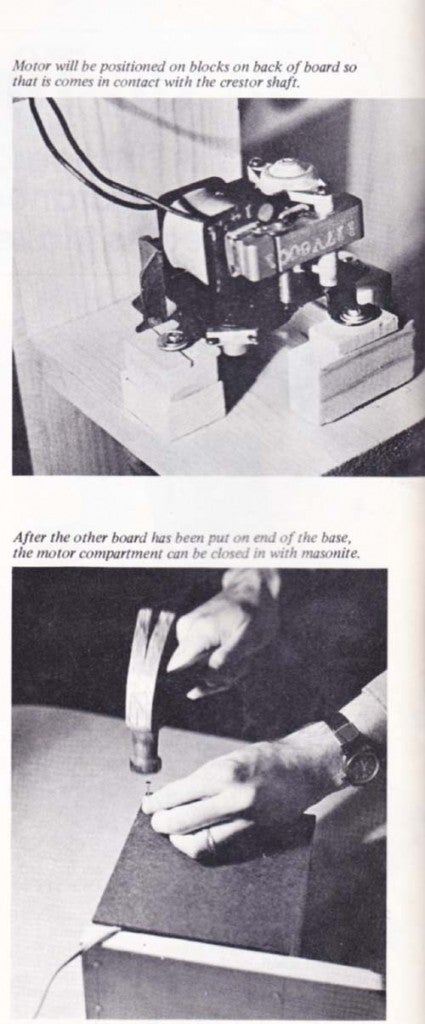








 Your Privacy Choices
Your Privacy Choices